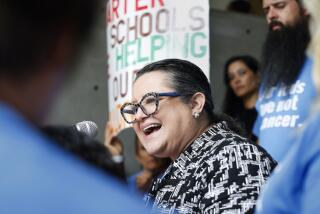State’s budget fakery takes a toll on charter schools
The CHIME Institute charter school of Woodland Hills would be hard pressed to make ends meet without the help of a program sponsored by the Local Initiatives Support Corp., a New York nonprofit active in underprivileged communities across the nation.
So why would everybody be happy if this LISC program went away?
The answer has much to do with the insane way California has been financing all its public schools, and charter schools in particular, for more than a decade. Since the financial crisis of 2001, the state has balanced its books in part by deferring money due to public schools by months at a time. Some smaller charter schools with limited borrowing history faced annualized borrowing costs of as much as 30% to cover the gap. If the state’s funding were not so self-defeating, the LISC program would not have to exist.
There is widespread agreement in government circles that the deferrals always were a lousy idea. Since bills keep coming due while state funding moves off toward the horizon, many school districts have had to take out bridge loans. But the problem is worse for charter schools, which typically can’t rely on their districts’ credit lines and function closer to the financial margin anyway.
But if there’s a bright side to the story, it’s that even the most shortsighted government policies can be moderated by an effective nonprofit effort.
“A lot of charter schools were running out of money,” Claudia Lima, the executive director at LISC’s Los Angeles office, told me. “The school needs to pay teachers, the light bill, overhead, but the money’s not coming in.”
LISC stepped into the funding breach a year ago by offering eligible charter schools low-cost financing through a process known as factoring. Put simply, it advances the schools a portion of the money they’re due from the state, and gets repaid once the funds finally arrive from Sacramento. (The difference between what it advanced and what it receives is the equivalent of an interest rate on a loan.)
Factoring is common in business, where companies sell their accounts receivable — money due from customers, say — so they don’t have to wait for the cash. It’s not so common in school finance; in fact, California is the only state where LISC has found a need for such a program. At the moment, the organization has closed about $7 million in financings to 12 schools, of which nine are in Los Angeles County, and it’s expanding the program to 11 counties outside L.A.
LISC dates from 1979, when it was started with $10 million in seed capital from the Ford Foundation and several big corporations to fund community development groups across the country. The Los Angeles branch provides grants and loans for projects including career training in South L.A. and small-business support in Little Tokyo.
A foundation operating at 30,000 feet, even with the best intentions, can’t necessarily figure out the best way to deploy its funds way down there on the ground. By the same token, local community groups and institutions don’t always have the reach to access national funding or use it as efficiently as possible. LISC exists to make the connection.
“We’re a channel for capital from government, corporations and foundations,” says Greg Maher, the organization’s senior vice president for lending. “We deploy it in neighborhoods where we have a physical presence by partnering with local groups” and offering them technical assistance and other support. As an example, he cites NFL Charities, which has provided LISC with $30 million to build, upgrade and maintain neighborhood ball fields in NFL cities. “We did the due diligence, working with low-income neighborhoods that wanted to rebuild football fields that were in disrepair and needed maintenance over time.”
The charter school financial crisis was another opportunity. LISC was already providing low-cost facilities financing for charter schools in California; it has helped with the funding for $22 million in middle and high school construction in East and South L.A. So it knew that the cycle of deferrals was forcing some schools to the breaking point. In designing the program, LISC tried to aim for schools with good academic performance and a high ratio of low-income students. Elementary and middle-school charters had to show a score of at least 700 — 650 if it had been open three years or less — on the state academic performance index scale of 200 to 1000. At least 30% of its students had to be eligible for free or reduced-price lunches.
The deferrals are typical of California’s addiction to childish fakery in dealing with its financial crisis. The first deferral, in the 2001-02 school year, moved $1.1 billion in payments to K-12 schools off by a few weeks, into the following budget year. Sacramento booked the shift as a budget savings, but since no district had to wait very long, there was a no-harm-no-foul air to the transaction. The state was hooked. From 2009 through 2011, the state added new deferrals totaling $6.3 billion and extending over much of the school year.
For the state, each deferral resulted in one-time savings amounting to a perpetually rolled-over loan from school districts; but the districts assumed the cost of the short-term borrowing needed to balance their inflow and outflow. The downside is obvious; money that should go to programs is diverted into borrowing costs. School budgets acquire a new level of uncertainty, for there’s always the chance that deferred payments will be deferred anew.
Gov. Jerry Brown has recognized this burden — how could he not? — by proposing in his 2013-14 budget to repay $1.8 billion in deferrals. That’s a start, but it covers only a fraction of the total deferred sum.
Large districts such as the Los Angeles Unified School District have been able to cover the deferral gap from their own reserves or in the short-term lending market. There are fewer options for charter schools, which are sponsored by local school districts but receive their state funding separately.
Many operate on a tightrope. That’s the case with CHIME, which was founded in 2001 as an outgrowth of an early childhood education program at Cal State Northridge. It currently educates 690 pupils in its K-8 division, of whom 20% have learning disabilities but are fully included in the educational program. Pupils are admitted by lottery, and the waiting list is about as large as the student body.
Under the best circumstances the school’s revenue and spending are almost exactly balanced at $5.18 million, according to its finance manager, Peggy Berrenson. So the cost of bridging the deferrals matters. Last year, CHIME signed on with LISC to factor $501,000 in deferred funding, at a cost of $19,200, or an annualized rate of 3.82%. That was considerably less than the school would have paid from a commercial lender and came with more flexible terms.
But as Berrenson accurately points out, that’s cold comfort given the folly of the original policy. “It’s unfortunate that we have to pay anything,” she says. “This is money allocated to the school, and it’s our funding by law.”
Could anyone have been fooled by the deferral scheme into thinking that the taxpayers, one way or the other, saved money? On the contrary, their taxes went for interest payments, loan origination fees and bond lawyers because Sacramento wanted to pretend it was enacting an honest budget.
Moreover, as LISC’s Maher points out, the budget deferrals take a toll on more than financial resources. “Nonprofit organizations have only a limited supply of human capital,” he says. Sacramento’s still-unresolved budget complex “takes the time of staff that could be devoted to real program work.”
In that case, that means schools properly supplied and students properly taught. When government screws up, here’s always more than money at stake.
Michael Hiltzik’s column appears Sundays and Wednesdays. Reach him at mhiltzik@latimes.com, read past columns at latimes.com/hiltzik, check out facebook.com/hiltzik and follow @latimeshiltzik on Twitter.







